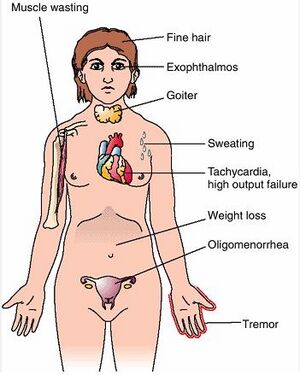Graves-Basedow disease
From WikiLectures
Graves-Basedow disease is an autoimmune' disease of the thyroid gland accompanied by its excessive function. It is the most common cause of hyperthyroidism and affects 4-5 times[1] more often women' rather younger age.
Pathogenesis[edit | edit source]
Antibodies against the TSH receptor are formed in the body, which after binding cause its activation. This leads to an increased production of thyroid hormones (T3 and T4). The same antibodies can also bind to antigens 'in the retrobulbar space (causing endocrine orbitopathy), in the subcutaneous tissue of the lower legs (pretibial myxedema), and on the hands and feet (acropachi ).
Symptoms[edit | edit source]
- goiter - diffuse, soft, richly vascularized (rustles can be heard when listening), nodule formation in elderly patients
- symptoms of thyrotoxicosis
- nervousness, lack of concentration
- increased temperature, sweating, heat intolerance, weight loss, increased appetite
- increased sympathetic activation − tachycardia', palpitations, dysrhythmia, hypertension
- increased GIT motility, 'diarrhea
- hyperreflexia, gentle hand tremor
- proximal myopathy - muscle weakness and atrophy, especially of the girdle muscles
- osteoporosis
- endocrine orbitopathy
- swelling of the soft tissues behind the bulb causes 'exophthalmos
- sympathetic activation increases the tone of the levator palpebrae sup. muscle, inhibits downward movement of the eyelids (Graefe's sign)
- lagophthalmos (not closing the eyelids) causes drying of the cornea and its erosion
- involvement of the eye muscles - 'diplopia
- compression of the optic nerve can cause blindness
- pretibial myxedema' - a rare symptom, it is subcutaneous edema with subsequent fibrotization and impaired lymph drainage
- acropachia - club-like swelling of the last joints of the fingers and toes, swelling of the nail beds
Note Older people tend to have circulatory symptoms and the so-called apathetic form (apathy, reduced mental reactivity).
Diagnostics[edit | edit source]
- increased serum values fT3, fT4, reduced TSH level (norm 0.3−4.2 mIU/l)
- presence of antibodies against TSH-receptors
- shortening of the Achilles tendon reflex
- ultrasound of the thyroid gland (reduced echogenicity) and retroorbital space
Differential diagnosis[edit | edit source]
- other causes of hyperthyroidism (e.g. toxic adenoma)
- other causes of protrusion of the bulbs (mainly in the case of a unilateral tumor, rule out)
Treatment[edit | edit source]
- thyrostatic drugs thiamazole, propylthiouracil'' block thyroid peroxidase (a serious side effect is agranulocytosis, occurring in less than 1 ‰ treated)<ref name="Klener"></ ref>
- β-blockers to alleviate hyperkinetic circulation
- thyroidectomy' in case of intolerance to thyroid medications, mechanical oppression and in women planning pregnancy, complications of the operation: removal of parathyroid glands (hypoparathyroidism), injury to the recurrent laryngeal nerve
- radioiodine (131I) if surgery is contraindicated
- orbitopathy usually recedes when the goiter is reduced with thyrostatic treatment, but if the eye problems worsen, we administer corticoids'
Links[edit | edit source]
Related Articles[edit | edit source]
- Thyroid hormones
- Hyperthyroidism, Thyrotoxic crisis
- Endocrine Orbitopathy
- Thyroid disease
- Graves-Basedow disease/case report
Source[edit | edit source]
- PASTOR, Jan. Langenbeck's medical web page [online]. [cit. 2010-05-19]. <http://langenbeck.webs.com>.
References[edit | edit source]
- ↑ PAVEL, Klener, et al. Internal Medicine. 4. edition. Prague : Galen, 2011. 1174 pp. pp. 943-945. ISBN 978-80-7262-857-5.


